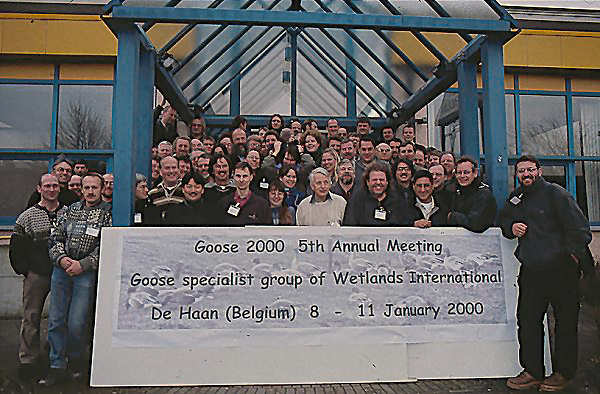Conference report
The coastal setting of the Belgian village De Haan served as a winter stop-over site for some120 goose specialists from 8 to 11 January 2000. Eckhart Kuijken and his enthusiastic team of the Institute of Nature Conservation hosted the energised flock from 20 different countries with great care and turned the annual event to a very inspiring meeting.

Preceded by 3 workshops on Svalbard pink-footed, lesser white-fronted and greylag geese on 7 January, the meeting started with a mixed-topic session on status reports and population distribution. This perfectly reflected the broad geographical scale Western palearctic geese exploit, embracing all their multifarious challenges and problems. The subjects touched upon conservation issues on the wintering grounds in Belgium, migration stop-over sites and breeding areas in Greenland and Arctic Russia. The session posed the major questions which were to form the thread running through the entire meeting: how many geese are using which areas at which stages of their annual cycle, what are the ecological bottlenecks and, in conclusion, what are the main management and conservation issues. Barbara Ganter and Jesper Madsen especially challenged the goose counting audience with a thought-provoking presentation on different methods of estimating population size (for Svalbard pinkfeet in this case) and the emerging margins for error.
One main focus of the annual meeting was the study of movements of individually marked geese using techniques such as coloured legrings, neckbands and radio-transmitters. For this day also many volunteer ring- and neckband-readers were present. The topic was brilliantly summarised by John Takekawa's overview of recent developments in satellite telemetry. Other presentations focused on regional distribution patterns (i.e. Kuijken & Verschuere on winter-staging pink-footed geese in Flanders, or Percival & Percival on site-loyalty in wintering Greenland barnacle geese), on larger scale shifts in wintering areas (i.e. Nilsson on Nordic greylag geese staging in south-western Europe), on survival estimates derived from ring readings (Madsen on annual and seasonal survival in pink-feet) and on the tracking of migration routes by means of satellite transmitters (Glahder, Fox & Walsh on spring migration of Greenland white-fronts, Green on spring migration in dark-bellied brent). Kruckenberg reported on the newly launched neck-banding project on European white-fronted geese. That challenging day was concluded by an interactive workshop demonstrating different techniques for the attachment of transmitter devices - especially interesting was the innovative tail-attachment method demonstrated by Iwabuchi Shigeki as a possible alternative to "traditional" backpack harnesses.
The second topic of the meeting focused on the management of wintering habitats for geese. Jouke Prop set the scene with his analyses on the role of farmland for geese, concluding that, although agricultural areas provide food of superior quality compared to natural habitats for winter staging geese, spring food quality of farmland is inadequate for the accumulation of sufficient protein reserves during the fattening period. Other contributions focussed on carrying capacity problems (i.e. Spaans for improved grassland, and Bos et al. for Wadden Sea saltmarshes), illustrated the effects of hunting on staging numbers and between-site distribution (i.e. Fox on staging site fidelity and Denny & Percival on the Lindisfarne refuge project) and showed the relation between social dominance and resource exploitation within a flock (Stahl et al. for Spitsbergen Barnacle Geese).
It was a fortuitous move by Bart Ebbinge and Eckhart Kuijken to choose a programme oriented towards two major scientific themes, since this gave added focus and bundled up the otherwise species-orientated approach of many of our goose projects into a greater synthesis. The lively discussions in the hallways of the De Haan conference venue proved this to be a promising concept to follow for our future meetings.
Two excursions, to the Belgian polders and the Dutch delta area respectively, provided the participants with fascinating views on large flocks of winter staging geese. The participants witnessed mainly barnacle, brent, white-fronted, greylag and bean geese with additional pink-feet and a single red-breasted goose, but they also went away with a better understanding of some of the problems and successes of managing wetland areas for waterfowl.
During the meeting, it was agreed to revive the Goose Specialist Group Bulletin that will re-appear as a first volume in October 2000, with contributions on ongoing projects as well as summarising content of the website. Tony Fox and Julia Stahl agreed to help the GSG-chairman Bart Ebbinge in editing both the website and the bulletin. We hope that the website and the bulletin will succeed in serving as a forum for discussion and contacts within the group for the foreseeable future.
The sixth annual meeting of the Goose Specialist Group will be hosted by Aivar Leito in Estonia from 27 April to 1 May 2001.
Julia Stahl, Tony Fox & Bart Ebbinge
Zoological Laboratory, University of Groningen, The Netherlands,
National Environmental Research Institute, Denmark,
and Alterra, Wageningen, The Netherlands.